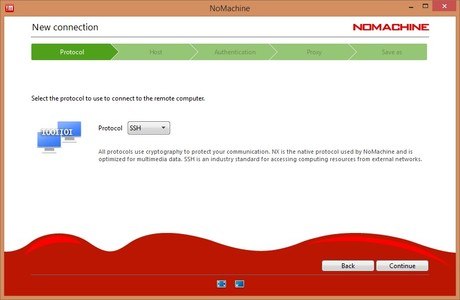
NOMACHINE AUR PASSWORD
Next, fill out the name and specify the password for the newly created user. Now click on the ‘ Add User‘ button to create a new user. Type in your password and hit ‘ Authenticate’ This will display currently created logon users as shownīefore you can begin creating users or change any settings, click on the ‘ Unlock‘ button at the far top right.Īn authentication dialogue box will open requiring you to enter your password and authenticate. On the left sidebar, navigate and select the ‘ Users‘ option.

Right-click on the desktop and select the ‘ Settings‘ option as shown: If you are not a fan of the terminal you can, instead, add a user on Ubuntu using the new-look and polished User interface of Ubuntu 20.04.
NOMACHINE AUR HOW TO
If you check the groups the user belongs to, you will found that sudo is among them: 1) How to add a user on Ubuntu using the graphical interface In our case, the command will be: $ sudo usermod -aG sudo cloudcone To grant users administrative privileges, add them to the sudo group as shown $ sudo usermod -aG sudo username This command displays the uid (user ID), gid (Group ID), and the group the user belongs to.Īdditionally, you can view the /etc/passwd file which contains hashed passwords of users on the system. Once the user is created, you can find more details about the user using the id command as shown: $ id
NOMACHINE AUR FULL
You will be prompted to provide your password and thereafter type in other details such as Full name, Room number and Tel. To add a user, use the syntax: $ sudo adduser usernameįor example, to add a user called cloudcone, issue the command: $ sudo adduser cloudcone To add a user in Ubuntu on the command line, launch your terminal by pressing Ctrl + SHIFT +T or use the application manager to search and launch the terminal. Let’s dive in and take a look at each of these ways of adding users in a Linux system: 1) How to create a user on the command line If you are using an instance of Ubuntu 20.04 LTS with a graphical interface, then each user will have a home directory with distinct sub-directories such as ‘ Documents‘, ‘ Downloads‘, ‘ Pictures‘, ‘ Music‘, and ‘ Videos‘ to mention a few. Using the Graphical User Interface (GUI).There are 2 main ways that you can add users on any Linux system: You can easily deploy a Cloudcone VPS or cloud server by visiting the cloud servers page. Adding users in any Linux system is one of the basic system administration tasks that any Linux user should be able to do with minimal effort In this topic, you will learn how to create a user on Ubuntu 20.04 LTS.
NOMACHINE AUR WINDOWS
The only other thing I can think of is, before installing Nomachine via AUR, I tried manually installing it as the site instructed before realizing it wouldn’t run on Manjaro, so I then removed the files before using the AUR installation.Like other operating systems such as Windows and Mac, Linux is a multi-user operating system that supports multiple users, each with their separate user accounts. I have tried uninstalling Nomachine, and reinstalling kde-plasma, neither have worked.


The same thing happens for programs that used to follow the system theme (being normal initially).

It does not effect: SVP4Linux, Yakuake, Telegram, and system icons (clipboard, volume, bluetooth, networking)ĭiscord specifically has the additional problem of not showing it’s icon - it is present in the first few seconds of loading my desktop, and dissapears when it has finished loading. The programs this specifically effects are: Discord, Caprine, Keybase, Onboard and Solaar. I’m not sure if this is the cause, but this happened the reboot after installing Nomachine.įor most taskbar icon’s that are not preinstalled on Manjaro (chat programs etc.) the icon’s aren’t corrosponding to the system theme (if they did previously), and left clicking does the same as right clicking, instead of opening like normal.


 0 kommentar(er)
0 kommentar(er)
